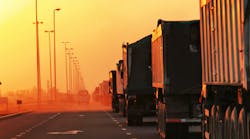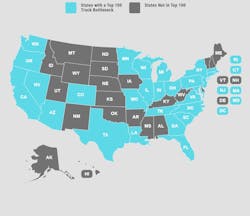The American Transportation Research Institute recently released its 13th annual list highlighting the most congested bottlenecks for trucks in America.
The 2024 Top Truck Bottleneck List measures the level of truck-involved congestion at over 325 locations on the national highway system. Based on a database of freight truck GPS data, the analysis uses several customized software applications and analysis methods along with terabytes of data from trucking operations to produce a congestion impact ranking for each location.
ATRI’s truck GPS data is also used to support state and federal freight mobility initiatives. The bottleneck locations detailed in this latest ATRI list represent the top 100 congested locations, though ATRI monitors more than 325 freight-critical locations.
See also: ATRI issues call for motor carriers and owner-operators to participate in detention survey
For the sixth year in a row, the intersection of I-95 and SR 4 in Fort Lee, New Jersey, is the No. 1 freight bottleneck in the country. Here are the Top 10 bottlenecks:
- Fort Lee, New Jersey: I-95 at Route 4 (George Washington Bridge)
- Chicago: I-294 at I-290/I-88
- Chicago: I-55
- Houston: I-45 at I-69/US 59
- Atlanta: I-285 at I-85 (North)
- Atlanta: I-20 at I-285 (West)
- Los Angeles: SR 60 at SR 57
- Houston: I-10 at I-45
- Atlanta: I-285 at SR 400
- Nashville: I-24/I-40 at I-440 (East)
“Traffic congestion on our National Highway System inflicts an enormous cost on the supply chain and environment, adding $95 billion to the cost of freight transportation and generating 69 million metric tons of excess carbon emissions every year,” ATA president and CEO Chris Spear said. “The freight bottlenecks identified in this report provide an actionable blueprint for state and federal transportation officials on where to invest infrastructure funding most cost-effectively. Increasing freight efficiency should be a top priority for the U.S. DOT, and alleviating these bottlenecks would improve highway safety, protect the environment, and support interstate commerce.”




